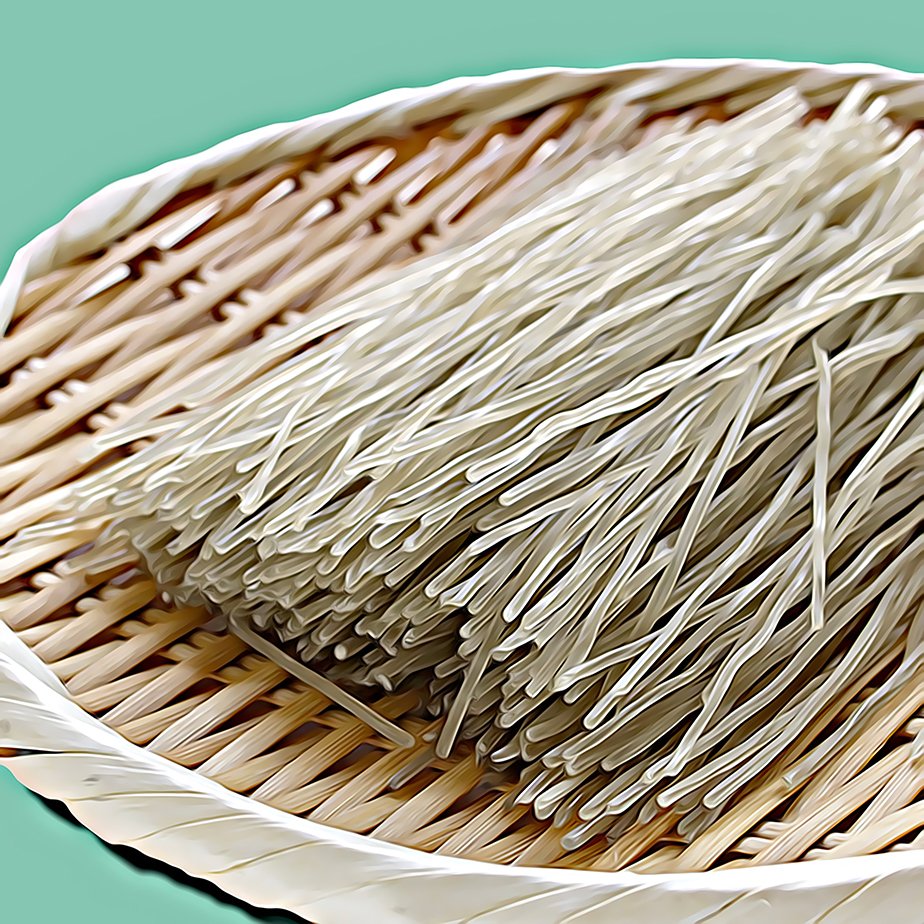Sweet potato starch noodles
Starch noodles are made from the starches of plants such as mung beans, cassava (tapioca), rice and, yes, even sweet potatoes. Their extracted starch is mixed with water to form a dough, then shaped into a variety of noodles. Some are as fine as vermicelli while others have a decidedly chunkier texture. With a translucent appearance and a chewy, slippery texture, they’re either dried or cooked fresh; the dried ones are easy to find in Korean, or more generally Asian, supermarkets. Unlike wheat noodles, starch noodles are gluten-free.
Sweet potato starch noodles, sometimes called glass noodles or dangmyeon, are versatile and nutritious. They’re not as wide-spread as many other noodles and are mainly popular in Korea and parts of China, although the Japanese have a version called harusame. In Korea, dangmyeon are a key ingredient in japchae, a savoury, slightly sweet stir-fry that combines the noodles with vegetables, meat, and a soy-based sauce. In China, sweet potato noodles are often used in hot pots and stir-fries where they add a unique texture and not a little bulk; they also pop up in fillings for stuffed fried and steamed regional breads. Harusame are a feature in stir-fries, soups, Japanese spring rolls, salads and hot pots.
The history of sweet potato noodles dates to early 20th century Korea. Over time, the noodles became popular due to their texture and versatility and spread to those other, neighbouring parts of Asia. FYI sweet potatoes are hugely popular in Korea, where they’re eaten roasted or steamed as a street food, in a version of bibimbap, in desserts and sides, and even in hot drinks. They’re dried too for use in soups and candied for snacks. Yum! South Korean sweet potatoes are small, purple on the outside, yellow inside, and quite sweet tasting.
Making sweet potato noodles is a relatively simple process. Basically (and this is the Golden Book version), the potatoes are processed finely and the raw flesh is blended with plenty for water. This mixture is left to sit so the starch can settle. After that, the water is carefully poured off, leaving the starch behind; at this stage it has settled to form a mass. The starch is mixed with water to form a dough, extruded into long strands of various thickness, then dried to create the brittle noodles we find in stores. (It is possible to make the noodles at home fresh; we watched a video of this in a domestic kitchen where 1.5kg of sweet potatoes yielded just 180g of starch. So it’s a bit laborious). Sweet potato noodles come in not only various thicknesses, but in different colours too. The Japanese ones are clear, whereas some Korean and Chinese ones are pale beige. Thin sweet potato noodles are like vermicelli and are used in soups , salads and spring roll fillings, while thicker, round ones are preferred for hot pots, stir-fries and other dishes where a more substantial texture is desired. Then, there are wide ones, which are also used tin hot-pots, soups and braised situations.
The taste of sweet potato starch noodles is neutral, making them an excellent base for absorbing the flavours of whatever they are cooked with. To prepare, they’re first soaked in hot water for about 10-20 minutes to soften; but always check the packaging of your noodles to check as the time can vary depending on the size and brand. After stalking they are briefly cooked and it’s important not to overdo this as they can turn mushy.
In China, sweet potato noodles are a key ingredient in several regional specialties:
Suan La Fen (Sour and Spicy Noodles): A popular street food from Chongqing. A hot and tangy noodle soup. it features a spicy-sour broth made with chilli oil, vinegar, and various seasonings. Sweet potato noodles add a chewy texture that balances the robust flavours.
Guo Qiao Mi Xian (Crossing-the-Bridge Noodles): Originating in Yunnan province, this dish features a rich and savoury broth into which raw ingredients, including sweet potato noodles, are added. The noodles cook quickly in the hot broth, providing a fabulous texture that complements the other components.
Chao Fen Tiao (Stir-fried Sweet Potato Noodles):A dish similar to Japchae but with different seasonings and regional variations.
In Korea, beyond japchae, sweet potato noodles are used in several other traditional dishes:
Bulgogi Hot Pot (bulgogi jeongol): This hot pot dish combines marinated beef bulgogi with a variety of vegetables and sweet potato noodles in a tasty broth.
Sundubu Jjigae (soft tofu stew): Although traditionally made with tofu, vegetables, and sometimes seafood, adding sweet potato noodles to this spicy and comforting stew is a common variation. The noodles provide an additional layer of texture.
Jjolmyeon: Although typically made with wheat flour noodles, sweet potato noodles can also be used in this cold, spicy noodle dish. The chewy noodles are mixed with vegetables and a tangy, spicy sauce, making it a refreshing and satisfying meal.
In Japan, haurame (sweet potato starch) noodles are used in dishes such as:
Harusame sarada (harusame salad): a light, refreshing salad, typically including the noodles and a variety of vegetables like cucumber, carrot, and capsicum plus a protein (ham, imitation crab, or prawns, maybe). The salad is tossed with a tangy soy sauce-based dressing.
Nikujaga: A popular home-cooked dish, nikujaga is a Japanese stew made with meat (usually beef), potatoes, and onions stewed in a sweet-savoury broth. Harusame noodles are sometimes added to soak up some stock and add a unique texture.
Mizutaki : A type of hot-pot, mizutaki is a simple dish where ingredients are simmered in a light dashi broth. Common components include chicken, tofu, mushrooms, and various vegetables, along with the harusame noodles. It's typically served with ponzu dipping sauce






